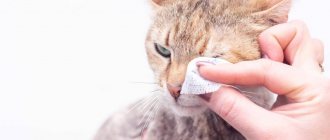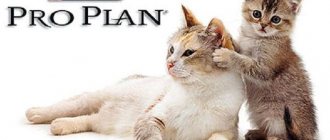How to properly and competently raise a kitten
We take a kitten into our home, tame it, but for some reason we don’t think about raising it at all. And when, having already become an adult, he begins to spoil our nerves with his behavior, we are surprised: “Where did our favorite go, where did he get such savage manners?” And only we ourselves are to blame for this - we missed the moments of his upbringing, so we got ourselves a headache instead of a pet! How to properly raise a kitten so that you don’t regret missed opportunities later?
First of all, you need to know that all manners of correct behavior in a kitten are formed in the subconscious, at the level of instincts. And such instincts need to be formed competently and correctly. This is the meaning of education! Moreover, you need to start raising it from the first days when the pet appeared in your home. Good manners will not appear in your kitten just out of the blue!
Don't forget about games
Article continues after advertisement
Sometimes a pet's overly intrusive, loud or gangster behavior is the result of boredom and unspent energy. Therefore, for a cat, there must be interactive toys and gaming complexes in the house: let him throw out all the crap while playing, instead of bothering the family. If you don’t have the money or space to install the complex and buy large toys, you can buy a regular tennis ball.
The basics of raising a furry pet
In order for your kitten's upbringing to go right, you need to know a little about their perceptual psychology. They are essentially predators and wild animals, so they perceive any punishment as an attack on them or an insult to their dignity. And they immediately begin to show their aggression, which can be expressed in different ways. If these are seals, then they begin to mark their territory, showing that they are the masters of the situation. If there are cats, then your sofas and armchairs may leave furry likenesses of them. Moreover, after such an “insult,” cats often try to take revenge by urinating in your shoes or on your bed. In order for your cat to become affectionate and not play dirty tricks anywhere, you need to educate him on clear concepts of “not allowed” and “allowed.”
What should he not do?
- Hang on curtains and clothes. For this, the kitten must be severely punished. When it is very small and weighs nothing, the problem is not big. But when it already weighs about 4-8 kilograms, what will be left of your things?
- Scratch or bite you even in play or out of affection. Cats often try to show their best feelings by biting - for them it is like a kiss for people. But scratching is a manifestation of the kitten’s negative emotions. And such manifestations must be nipped in the bud. When the “fluffy” is small, he does not cause much damage with this behavior. But when you get older, you will be guaranteed injuries and infections!
- Sleep on your head. Although it is believed that cats heal sore spots in humans, you should not allow a kitten to sleep on your head or neck, chest or stomach. It will become larger and heavier, but the habit of sleeping on you will remain at the level of instinct, and it may simply disturb your breathing in your sleep. At best, this will lead to bronchial asthma, at worst, it can be fatal.
- Eat from your plate or next to your table. You can’t teach a kitten to “bite” or eat from your plate - it will grow up to be a terrible mischief and you won’t be able to leave anything on the table. He should only have his own dishes, located away from your table. Will it be pleasant for you when guests are sitting at your table, and your cat (kitty) jumps on the table and tries to eat from all the plates at once? Or rubs against your legs and begs for pieces of tasty food?
- Flower pots and indoor plants are taboo for him! This is the problem of all cat owners - spoiled flowers and soil from flower pots scattered everywhere. There are only two options to avoid all this - place pots with plants in places inaccessible to the kitten (which may not always work). Or teach the mischief-maker that he will be severely punished for such offenses.
To prevent your cute and playful kitten from growing into a terrible house tyrant, you need to raise him from an early age and correctly! Moreover, for different breeds of kittens, these rules of upbringing, although not too different from each other, still have such differences.
Features of raising a Scottish fold kitten.
Scottish Fold kittens are very intelligent and trusting. With proper upbringing, a kitten of this breed will become affectionate and problem-free. It is easy to train a Scottish kitten to the command “no!” or “ugh!” simple, simultaneous with the spoken word, tapping on a hard surface with a rolled-up newspaper (magazine). Such “paper” scares allow the kitten to internalize this command subconsciously. Then he will perceive the word itself as a slap with paper.
Your Scotsman needs to be praised for following a command so that he understands the “carrot and stick” method. You can’t hit a lop-eared dog; he stops trusting his owner and may simply run away from you. But there were other cases - these were the kittens that refused food and died from exhaustion due to beatings from their owners!
Origin of Scottish cats
It is not always possible to find out which cat the breed came from. But in the case of Scottish cats, this is easy to do. Once upon a time, a fold-eared kitten, Susie, was born on a farm in Scotland, which gave a huge impetus to long selection work to develop a new breed of cats. Of course, this is not the first lop-eared cat in the world, but only Susie became truly interested, and in the 60s of the last century the history of the Scottish cat breed began.
The offspring of the cat Susie were crossed with the British and got cats that resemble round-headed owlets.
The breed had many problems due to the semi-fatal gene for lop ears, which weakens the cartilage of the ears and other bones. Geneticist R. Peltz got down to business, and thanks to his work dedicated to solving problems with lop-eared genes, the result of the research gave working instructions for crossing Scots. It was clear that under no circumstances should fold-eared cats be crossed with fold-eared cats, so British cats are used for breeding.
Features of raising a Sphynx kitten.
These are very independent Canadians - Sphynx kittens! Therefore, their upbringing must be approached with special care and attention. Raising such a sphinx is not easy, but then it will be an ideal pet. Cats of this breed are very touchy, independent and consider themselves the main ones in the house - this should be taken into account. Therefore, the kitten must not only be taught the desired behavior, but also freed from “royal habits.”
- The Sphinx begins to mark its territory. Here we need to find out why he is doing this, what bothers him. This could be severe stress (punishment by beating, moving to a new home, getting another pet), or it could be the beginning of a disease. This can also be an affirmation of your Sphynx's rank in your home. It is best to contact your veterinarian for advice; he will tell you what to do in your specific case.
- Your Sphynx has started to dirty your bed. Here again there are several possible reasons: the cat doesn’t like the place for his litter box, your cat is very offended by you. In the first case, you can simply change the place for the tray several times and see which one your Sphynx chooses. The second one is a little more difficult! You need to spray the sphinx with water from a spray bottle or give it a light slap with a wet rag. Then cover the bed with oilcloth, spraying it (the oilcloth) with a little “White.” This “not your” smell will scare away the kitten, and it will stop even coming to the bed.
- Your pet attacks your guests. If this happens, then again there are two options for ridding the Sphinx of a bad habit. The first is to isolate the kitten before guests arrive. The second is to hand out spray bottles of water to all guests upon entry. The results will be quite fun “shooters”, and then your pet will learn not to attack strangers. This is from the Sphinx's independence!
With the help of these rules, a proud and independent sphinx can be turned into an affectionate and sweet cat!
Peculiarities of raising a British person.
British cats (and cats) are very balanced and calm - this is well known to everyone. But their kittens, like all kids, are playful and mischievous. So that this childish spontaneity of theirs does not become the basis of their character, the British must be raised from the first days of their appearance in the house.
It is these kittens who understand the intonations of the human voice well. To develop their instinct for the word “no!” It’s enough just to change your intonation to a reproachful one and just raise your voice slightly. There is no need to shout, they are afraid of loud noises! It is easy to train a British kitten to the litter box - just show him his place a couple of times and stroke him when he “does his job” there.
But for any Briton, a proper diet is very important. You simply must obtain recommendations on such a diet from the breeder and veterinarian. And be sure to follow all hygiene procedures, especially since these cats, accustomed from childhood, simply adore such procedures.
These are the features of raising furry pets. If you do this from the very first days your “fluffy” appears, you will get an ideal and obedient pet for the whole family!
Source
No - brute force
First you need to figure out how Scottish kittens behave and why. Each behavior has its own logical explanation. Therefore, there is no need to immediately, headlong, rush to punish for the trick. Understand its reasons first.
Article continues after advertisement
If you have had dogs in your house, then you probably know that they need to be raised from a position of strength, showing that you are the leader. Otherwise the dog will not respect you. With a cat, everything is different - raising Scottish fold and straight-eared kittens is different from raising puppies: they do not accept punishment and rudeness, screaming and spanking. There are times when an animal begins to simply ignore a person for rough treatment.
Raising a Scottish Fold or Straight-eared cat should be soft, affectionate, and cunning. For example, many cat owners are faced with the problem that a kitten or even an adult cat walks on the computer keyboard. The author of the article taught his kitten to do this in a completely simple and affectionate way: every time his Scottish cat tried to walk across the keyboard, a barrier was put up with his hands so that the tailed creature would go around. And literally a month later, the cat stopped climbing on the keyboard, and instead walked around it.
Appearance
The Fold cat has gained popularity due to the fact that it has a gentle character and beautiful appearance. The animal has a rounded head and a firm chin. The cat's jaw is powerful, extending into a small neck. The cat has beautiful round eyes, their shade goes well with the coat.
Cats have a short nose, but at the same time wide. If you look at the pet, its profile is streamlined and soft. The cat's ears point forward and are triangular in shape. The tips of the ears are slightly rounded.
Character
The Scottish cat has a slightly playful character, kindness and calmness. This breed becomes strongly attached to its owner and is good friends with other pets and small children. The main advantage of the Scottish cat is silence; they rarely meow and are very quiet.
This breed will be ideal for a person who leads a quiet life without fuss. Small lop-eared kittens may behave badly as children, but do not cause damage to the home. Animals love to hide various small objects. These cats love cleanliness very much, they are quite smart.
Adult cats are affectionate, calm and understand everything well. They know how to obey if it is in their interests. They can be stubborn if they don't want to do something. This breed loves to be friends with people; cats choose their leader and are constantly with him. Animals are very loyal, but never impose themselves. They love to lie near their owner, but not in a person's arms.
Most owners say that this breed is considered an ideal pet, as it does not harm and is well-bred. Externally, cats are cute, beautiful and gentle, they will not leave anyone indifferent. The character of the Scottish cat itself is good and harmless.
Feeding with bagged food
Those who have decided to feed their Scottish Straight exclusively with specialized food should be aware that most existing food can be classified into 3 main characteristics: cheap, average and elite, also known as premium or super-premium.
Cheap food has already been discussed here. It is these economy class packages that constantly appear in television and online advertising. They are cheap and their primary purpose is to satisfy the cat's hunger. For this purpose, a lot of by-products are placed there and, in addition to them, dyes and enticing fragrances.
Naturally, it is better to protect your pet from such food, since eating it threatens the occurrence of serious and long-term illnesses.
Those who purchase medium-priced packages should not assume that there is anything in there beyond by-products and slightly better quality dyes. Of course, these are somewhat better than economy class, and are valued higher, but it is not advisable to put too much stress on them.
Scottish Straight cats should be pampered with premium and super-premium food. They, of course, cost a lot, but they contain only meat and cereals, and there are almost no dyes or fragrances in them, so they can be used on a regular basis.
Good to know - the best premium food for Scottish Fold kittens.
One could see that taking care of Scottish Straights is not at all difficult. However, it is worth organizing everything necessary for your future pet in advance, by reading the necessary manuals and consulting with experts on various issues in order to prepare for various difficulties that may arise in the future.
Health
Scottish cats have a genetic predisposition to various diseases. This may not occur in all animals, but it is important to be aware of what problems a future owner may face. Thus, fold-eared cats are predisposed to diseases that are associated with the skeleton. Osteochondrodysplasia, which is inherited, is not excluded. This disease causes skeletal deformation, impaired movement and problems with the tail. The disease can develop in both a kitten and an adult.
The following signs of pathology are observed:
- lameness;
- stiff gait;
- avoidance of jumping;
- touching the cat's tail hurts;
- the animal walks squat.
Scottish cats are prone to heart disease. If you get vaccinated and visit your doctor regularly, preventive measures can improve your pet's life. On average, this breed lives from 10 to 15 years.
Scottish cat care
Fold cats themselves adore cleanliness and take good care of themselves. They get their coats in order and quickly become toilet trained. If you have a scratching post at home, cats will not damage the furniture. Scottish cats quickly remember everything and try to behave well.
We must not forget that there must be care for the coat of a Scottish cat. If your pet has a short coat, it will be easier to care for it. Then you will need to comb the cat once a week with special brushes.
You need to wash the animal depending on its coloring. As a rule, it is recommended for a cat to take water treatments once a month. If a cat participates in exhibitions, then it is washed a week before the event. You need to purchase a special shampoo for this breed.
Regular examination of the ears and eyes is a must. Most often, Scottish cats have clean ears. If dirt becomes noticeable, take a cotton swab and remove the dirt. It is best to use special lotions to clean the ears. The eyes become wet in small kittens, so you need to apply eye drops and monitor the condition of the animal.
Upbringing
If a pet has some bad habits, it will be difficult to wean it. It is better to try to prevent their appearance. As soon as the kitten appears in the house, he must understand what is allowed to do and what is not allowed.
Scottish cats are required to adhere to the following rules in the house:
- do not scratch furniture;
- rest and go to the toilet in the right places;
- do not harm the plants that are in the house;
- be friends with all pets;
- do not climb on tables or steal food;
- maintain cleanliness;
- do not show aggressive behavior.
Do not yell at the cat, otherwise it will become aggressive and will not trust its owner. The little kitten gets used to the new place and owner quickly. If the animal does something wrong, then you need to say the command “no” and lightly spank it. This breed loves to interact with people, and cats need to be played with regularly.
Accustom to affection
Scottish cats, despite their plush appearance, do not always like to be held and do not always like to be actively petted. Unfortunately, this problem is not completely solved; it is simply a character trait that must be put up with. But you still need to carry out a certain ritual to accustom him to hands. To do this, in the first days of the kitten’s stay in the house, try not to forcefully pick it up, but only stroke its back and head. We must make it clear that hand caresses are pleasant. And only after a few days try to pick him up, if, of course, he hasn’t come to you before. This way your cat will gradually get used to your hugs. One more nuance: when you take a Scottish cat in your arms, you need to make sure that its butt, hind and front legs have solid support, otherwise the animal will feel insecure.
Preparing for the arrival of a Scottish kitten in the house
The character of the Scottish Fold cat is quite calm and lazy. To keep such a pet you will need a small amount of space. There is one drawback that in childhood the kitten is very playful and energetic.
Before purchasing a pet, you need to prepare as follows:
- Remove all wires, cables, phone charging devices, things that break. Small items will also need to be hidden for the safety of the pet so that he does not swallow them.
- You need to purchase dishes for eating food and water. You need to buy one made of ceramic or metal material to avoid the bowls from tipping over.
- You should purchase a tray and a special filler for it. It is necessary to accustom a Scottish cat to the toilet from the first hours in the house. It is best to buy a tray that has low sides.
- A place to relax. It is necessary to purchase a bed or a special house for sleeping. A Scottish cat can get used to sleeping with its owner, then a designated place will not be needed.
- Scratching post. It must be so that the kitten does not damage things and furniture in the house.
- Toys. This will help distract the baby from hooliganism, as he will be busy playing.
When an animal appears in the house, it must be immediately accustomed to a place for toileting and food. It is imperative to ensure that the kitten eats only from a bowl, then the food will not end up on the floor. As a rule, kittens are sold that are already litter box trained. In the first days, the baby may not be able to find the toilet on his own, so you need to show it to him constantly.
Nutrition
Every responsible owner must correctly approach the organization of the diet for his Scottish kitten from the first days of his life. Sometimes it may happen that the pet will have a poor appetite, but this may be due to the fact that cats of this breed simply need time to get used to the new environment. Remember that feeding the kitten should only be done with warm food, but never cold food.
If your kitten is several months old, then it needs to be fed about 5 times a day. When your lop-eared pet reaches 4-8 months, you can start feeding him 3 times a day. After 8 months of age, the cat can be fed 2 times a day, just like an adult.
You can feed your Scottish Fold kitten with homemade food or purchase special food; here everything depends only on the owner’s decision. If you decide to cook for your cat yourself, you can give him chicken or beef. In order for your pet to fully develop, you should sometimes give him some fermented milk products. Also, if we talk about the care and feeding of fold-eared cats, it should be noted that they are forbidden to give smoked meats, fried and salty foods, and semi-finished products.
If you decide to purchase special food, this will be an excellent decision, because premium food contains all the minerals and vitamins necessary for a Scottish cat, which will not only improve your pet’s health, but also make its coat shiny. It's up to you to decide how to feed your Scottish Fold cat.
Breed Features
A good advantage of the Scottish cat is its good learning ability and love of cleanliness. Most cats of other breeds love to take revenge, but the Scotsman will never do this. From childhood, they quickly understand the toilet and learn to sharpen their claws in the right place.
You can go on a trip with this breed, as cats can easily tolerate travel. They quickly get used to new places and often participate in exhibitions.
The Scots have a calm and balanced character. This breed feels comfortable in an apartment, as they do not like to live in the yard. A fold-eared cat does not require a lot of space and care, but you need to give the pet the necessary attention. It is best to take the animal outside for socialization purposes.
Scottish Fold cats are friendly and affectionate in nature. It is important that the animal is raised from the very first days in the house. Then you will be able to raise a good and cute cat. The main thing is to love and caress your pet, and then the owner will receive reciprocity.
Source
Love a cat
If you truly love your pet, you will never allow him to do anything that is harmful to him, you will never hit him, you will not forbid him to sleep next to you and do the like. And most importantly, you will not artificially limit his freedom, for example, by excessive caresses. The cat, in turn, always feels that he is loved and respected.
And cat love is designed in such a way that love will not arise for those whom the cat does not trust. Therefore, first of all, earn the trust of your pet. But if you already see that the cat loves and trusts you, rest assured: this is not an act, because cats do not know how to portray such emotions. Any others know how (for example, resentment), but love does not.
Do you have your own tips for raising a Scottish cat? Or, on the contrary, you are confused and don’t know what to do with the problem. Share this in the comments.
Rate and share!











